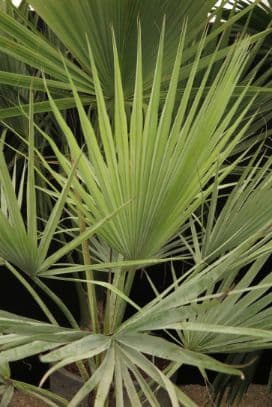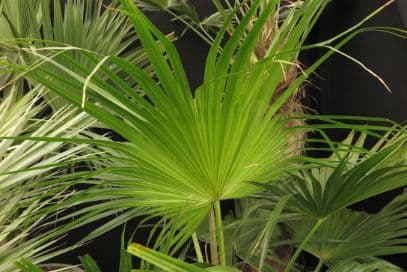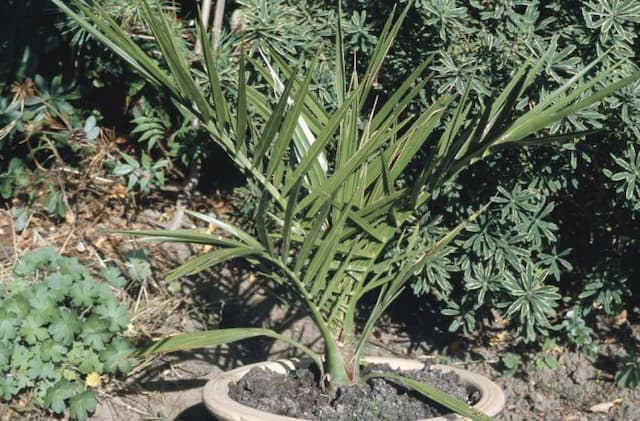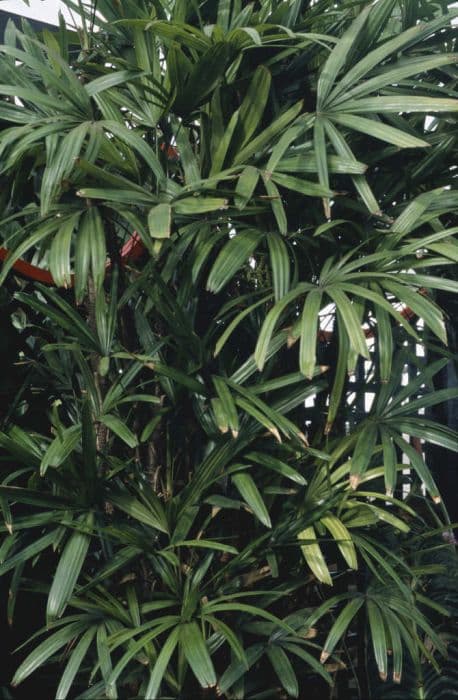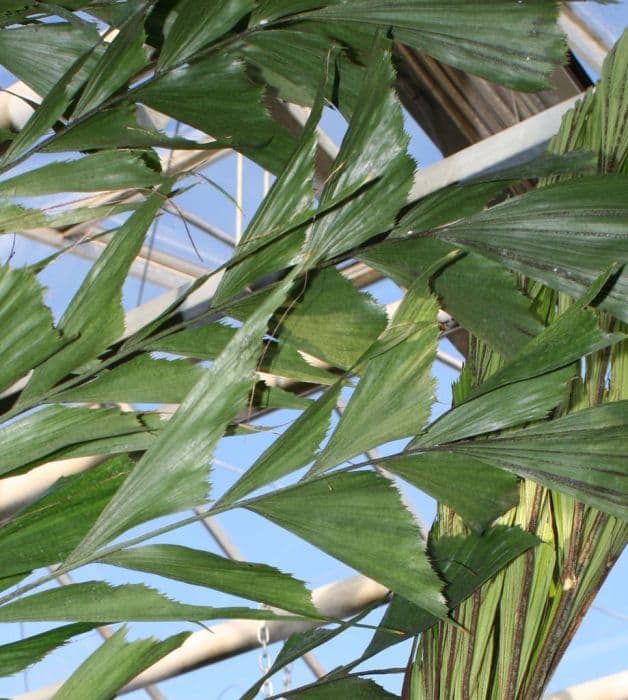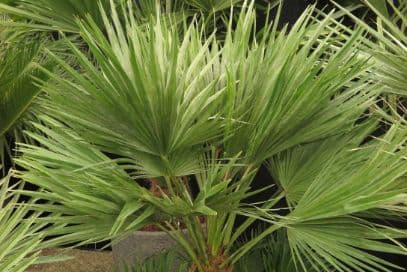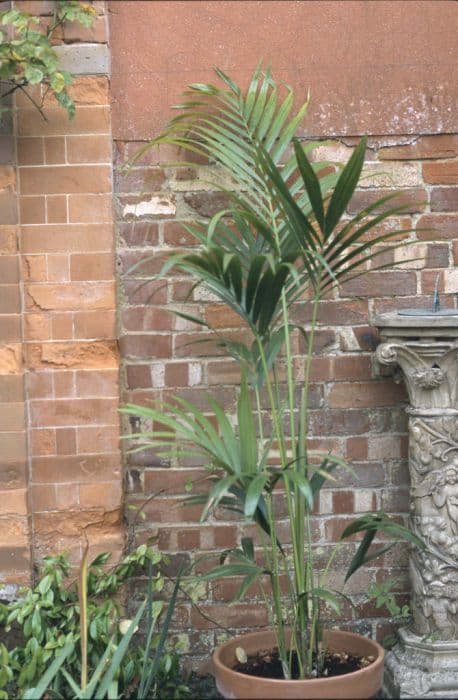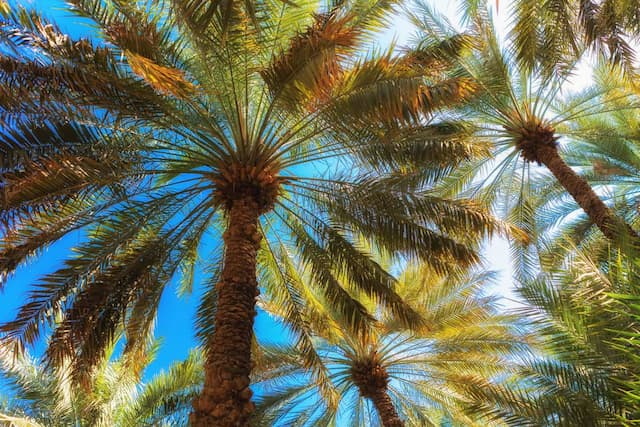California fan palm Washingtonia filifera
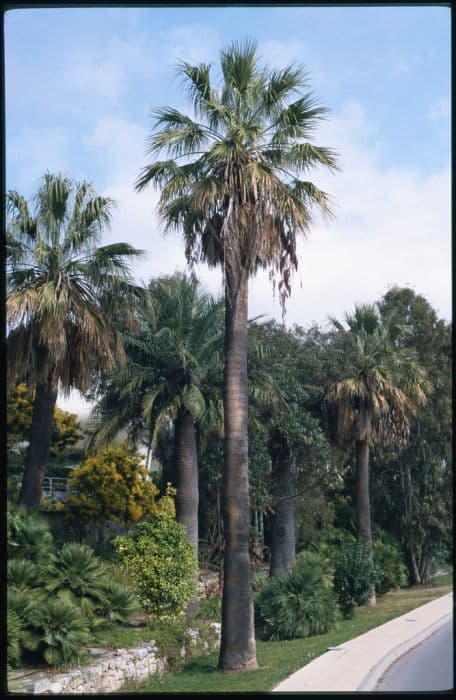
ABOUT
a medium to large palm, with a robust trunk. The long leaf stalks have sharp teeth near the base, and the fan-shaped, grey-green blades up to 3m long are erect at first, then spreading and arching. Dead foliage remains on the plant, hanging down to clothe the whole trunk. Creamy-white, tubular flowers are produced in huge sprays up to 5m long, usually in summer
About this plant
 Names
NamesFamily
Arecaceae.
Synonyms
California Fan Palm, Petticoat Palm, Desert Fan Palm, American Cotton Palm, California Washingtonia, Washington Palm.
Common names
Neowashingtonia filifera, Pritchardia filifera, Washingtonia filamentosa, Washingtonia filifera var. microsperma, Washingtonia robusta.
 Characteristics
CharacteristicsLife cycle
Perennials
Foliage type
Evergreen
Color of leaves
Green
Flower color
White
Height
49 feet (15 meters)
Spread
10 feet (3 meters)
Plant type
Palm
Hardiness zones
8
Native area
Southwest USA
Benefits
 General Benefits
General Benefits- Shade Provider: Washingtonia filifera, also known as the California fan palm, offers ample shade with its broad leaves, making it an excellent choice for sun protection in gardens and parks.
- Landscape Aesthetics: With its tall stature and striking appearance, it is often used as an ornamental plant to enhance the visual appeal of landscapes.
- Habitat for Wildlife: Its fronds and seeds provide shelter and food for various bird species, insects, and small mammals.
- Erosion Control: The robust root system of the California fan palm can help stabilize soil and prevent erosion, particularly in sandy environments where it naturally thrives.
- Cultural Significance: Native to the Southwest U.S., it has historical importance and serves as a characteristic element in regional landscaping.
 Medical Properties
Medical PropertiesThis plant is not used for medical purposes.
 Air-purifying Qualities
Air-purifying QualitiesThis plant is not specifically known for air purifying qualities.
 Other Uses
Other Uses- Thatch Material: The leaves of the California fan palm can be dried and used as thatch for roofing material in traditional building techniques.
- Woven Crafts: Fronds from the California fan palm are used to weave baskets, hats, and mats by indigenous peoples and craftsmen.
- Livestock Feed: The fruit of the California fan palm is sometimes used to feed livestock when other food sources are scarce.
- Edible Fruit: The fruits, known as "Washingtonia," can be eaten raw or turned into jelly.
- Shade Provider: Planted in hot climates, the California fan palm provides critical shade for people, pets, and underplantings.
- Streambank Stabilization: This plant's extensive root system helps stabilize streambanks and prevent erosion in its native habitats.
- Cultural Significance: The California fan palm plays an important role in the cultural practices and ceremonies of Native American tribes.
- Habitat for Wildlife: The dense foliage and skirt of dead leaves provide shelter for birds and other wildlife.
- Fiber Material: Fibrous material from the California fan palm can be gathered and used for making rope or crude textiles.
- Landscape Ornamentation: The unique and striking appearance makes the California fan palm a popular choice for ornamental purposes in gardens and parks.
Interesting Facts
 Feng Shui
Feng ShuiThe California palm is not used in Feng Shui practice.
 Zodiac Sign Compitability
Zodiac Sign CompitabilityThe California palm is not used in astrology practice.
 Plant Symbolism
Plant Symbolism- Resilience: Washingtonia filifera, commonly known as the California fan palm, is known for its ability to thrive in the arid desert environment, symbolizing the ability to withstand tough conditions and adversity.
- Oasis: As these palms often indicate the presence of water in their native desert habitats, they have come to symbolize an oasis or a haven in difficult times.
- Longevity: The California fan palm can live for 80 to 250 years, making it a symbol of long life and endurance.
- Protection: The robust trunk and the fan-shaped canopy of the palm provide shade and shelter in its natural habitat, symbolizing protection and caretaking.
 Water
WaterCalifornia Fan Palms should be watered deeply but infrequently to encourage deep root growth. They can tolerate some drought once established but perform best when watered every two to three weeks during the active growth season. When watering, provide about 15-20 gallons per session for mature palms to ensure the soil is moist but not waterlogged. During the cooler months, reduce watering to once a month or less, depending on the rainfall and temperatures in your region. Consistent overwatering can lead to root rot, so ensure good drainage and allow the soil to dry between watering sessions.
 Light
LightCalifornia Fan Palms thrive in full sun conditions and require at least 6 to 8 hours of direct sunlight daily. The best spot for planting is an open area where the tree receives unfiltered sunlight throughout the day. This species is well adapted to high light environments and may not grow as vigorously in shaded or partially shaded areas.
 Temperature
TemperatureCalifornia Fan Palms are hardy in a range of temperatures and can withstand lows down to around 20 degrees Fahrenheit, though they prefer warm climates. Ideal growing temperatures for the fan palm are between 70 and 100 degrees Fahrenheit. This palm is not frost-tolerant and can suffer damage if exposed to temperatures below the 20-degree Fahrenheit threshold for extended periods.
 Pruning
PruningPruning California Fan Palms is primarily necessary to remove dead or dying fronds and to maintain a tidy appearance. It's best to prune in the spring or summer when the palm is actively growing. Pruning once or twice a year is sufficient, and care should be taken not to over-prune or remove green fronds, as this can weaken the palm. Use clean, sharp tools to make clean cuts and avoid damaging the trunk.
 Cleaning
CleaningAs needed
 Soil
SoilThe California palm, or Washingtonia filifera, thrives best in a soil mix that is well-draining and sandy, with a pH range of 6.0 to 8.0. A good mix would be equal parts of standard potting soil, coarse sand, and peat or coconut coir to ensure proper drainage and aeration of the roots.
 Repotting
RepottingCalifornia palms need repotting every 3 to 4 years. It’s important to increase the pot size each time to accommodate the growing root system of the Washingtonia filifera. Wait until the palm is root-bound before repotting.
 Humidity & Misting
Humidity & MistingCalifornia palm is adaptable to a wide range of humidity levels but prefers moderate to high humidity. Ideal humidity for Washingtonia filifera would be around 40-75%, which simulates its natural desert-like environments.
 Suitable locations
Suitable locationsIndoor
Place in bright, indirect light and ensure well-draining soil for California palm.
Outdoor
Plant in sunny spot, protect from cold, provide spacious area for growth.
Hardiness zone
8-11 USDA
 Life cycle
Life cycleThe life of the California fan palm (Washingtonia filifera) begins with seed germination, which typically occurs in moist, warm environments. The seedling stage follows, with the young palms growing a root system and a single, spear-shaped leaf. As the palm matures into the juvenile stage, it develops a sturdy trunk and a crown of fan-shaped leaves. In adulthood, the California fan palm reaches heights of up to 60 feet and produces flowers that are pollinated by wind and insects. After pollination, the flowers develop into small, black fruits that contain seeds, thereby enabling the cycle to start anew once these seeds are dispersed, often by animals or water. Throughout its life, which can span over 80 years, the palm will periodically shed its oldest fronds, allowing for continuous growth and renewal.
 Propogation
PropogationPropogation time
Spring to Summer
Propogation: The most popular method of propagating the California palm or Washingtonia filifera is through its seeds. The best time to sow the seeds is during spring or early summer when temperatures are consistently warm, which is crucial for germination. To propagate, first, soak the seeds in warm water for 24 to 48 hours to soften the seed coat. After soaking, sow the seeds in a well-draining soil mix at a depth of about 1/4 inch (0.6 cm). Keep the soil moist but not waterlogged and maintain a temperature around 80 to 85 degrees Fahrenheit (27-29 degrees Celsius). Germination typically occurs within one to three months, and once seedlings have developed a few sets of true leaves, they can be carefully transplanted into individual pots to continue growing.


